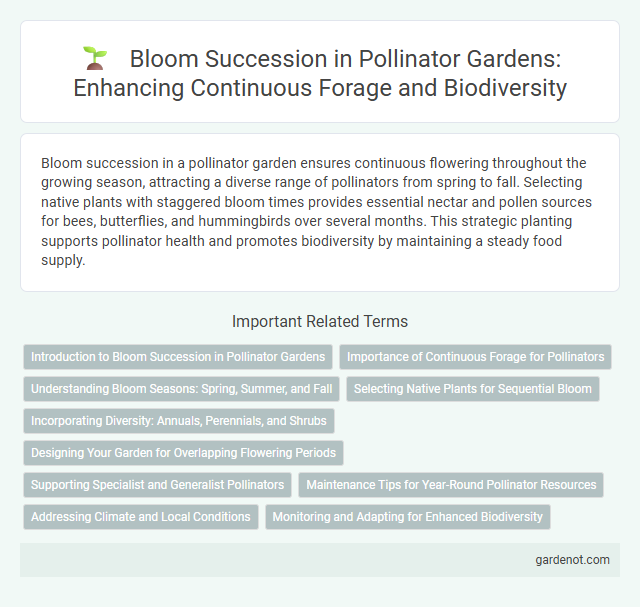Bloom succession in a pollinator garden ensures continuous flowering throughout the growing season, attracting a diverse range of pollinators from spring to fall. Selecting native plants with staggered bloom times provides essential nectar and pollen sources for bees, butterflies, and hummingbirds over several months. This strategic planting supports pollinator health and promotes biodiversity by maintaining a steady food supply.
Introduction to Bloom Succession in Pollinator Gardens
Bloom succession in pollinator gardens ensures continuous floral resources from early spring to late fall, supporting diverse pollinator species throughout their active seasons. Selecting plants with staggered flowering periods, such as early-blooming crocuses, mid-season coneflowers, and late-blooming asters, maximizes nectar and pollen availability. This strategic planting enhances ecosystem stability, attracting bees, butterflies, hummingbirds, and other pollinators vital for garden health and biodiversity.
Importance of Continuous Forage for Pollinators
Continuous bloom succession in a pollinator garden ensures a steady supply of nectar and pollen, essential for the health and survival of bees, butterflies, and other pollinating insects throughout the growing season. Strategically planting a diverse array of flowering species with overlapping bloom periods supports pollinator populations by providing consistent forage resources from early spring to late fall. This uninterrupted availability of food sources fosters pollinator reproduction, enhances pollination efficiency, and contributes to overall ecosystem stability.
Understanding Bloom Seasons: Spring, Summer, and Fall
Bloom succession in a pollinator garden ensures continuous nectar and pollen supply across spring, summer, and fall, supporting diverse pollinator species. Early spring blooms like crocus and red maple provide vital resources for emerging bees, while summer flowers such as coneflowers and milkweed sustain butterflies and hummingbirds. Fall bloomers including goldenrod and asters extend foraging opportunities, helping pollinators build reserves before winter.
Selecting Native Plants for Sequential Bloom
Selecting native plants with staggered bloom times ensures continuous floral resources for pollinators throughout the growing season. Incorporating species such as purple coneflower (Echinacea purpurea), goldenrod (Solidago spp.), and wild bergamot (Monarda fistulosa) promotes a diverse and resilient pollinator garden. Sequential bloom supports varied pollinator species by providing nectar and pollen from early spring through late fall.
Incorporating Diversity: Annuals, Perennials, and Shrubs
Incorporating a variety of annuals, perennials, and shrubs ensures continuous bloom succession throughout the growing season, providing essential nectar and pollen sources for diverse pollinators. Annuals like cosmos and sunflowers offer vibrant early-season blooms, while perennials such as coneflowers and bee balm sustain mid-season activity, and shrubs like butterfly bush extend flowering into late summer and fall. This layered plant diversity supports a wide range of pollinator species, promoting a healthy and resilient pollinator garden ecosystem.
Designing Your Garden for Overlapping Flowering Periods
Designing a pollinator garden with intentional bloom succession ensures continuous floral resources throughout the growing season, attracting diverse pollinators such as bees, butterflies, and hummingbirds. Select native plant species with staggered flowering times from early spring to late fall to maintain overlapping blooming periods and support ecosystem health. This approach maximizes nectar and pollen availability, enhancing pollination efficiency and promoting biodiversity in your garden.
Supporting Specialist and Generalist Pollinators
Bloom succession in a pollinator garden ensures continuous nectar and pollen sources throughout the growing season, benefiting both specialist and generalist pollinators. Incorporating plant species with staggered flowering periods such as milkweed for monarch butterflies (specialists) and coneflowers favored by a wide range of bees and butterflies (generalists) maximizes habitat support. Diverse bloom timing enhances pollinator nutrition and ecosystem resilience, promoting sustainable pollination services.
Maintenance Tips for Year-Round Pollinator Resources
Maintaining a pollinator garden for year-round bloom succession requires planting a diverse range of native flowers that bloom at different times throughout the seasons, ensuring continuous nectar and pollen supply. Regular deadheading and pruning encourage new growth and prolong flowering periods, while mulching helps retain soil moisture and suppress weeds. Monitoring for pests with eco-friendly methods preserves plant health, supporting a stable habitat for bees, butterflies, and other pollinators all year long.
Addressing Climate and Local Conditions
Bloom succession in pollinator gardens is carefully planned by selecting native plant species that thrive in specific local climates and soil conditions, ensuring a continuous supply of nectar and pollen throughout the growing season. This approach supports diverse pollinator populations by providing staggered flowering periods that align with their life cycles and activity patterns in the region. Adjusting plant varieties based on climate data and microhabitat characteristics maximizes garden resilience against temperature fluctuations and precipitation variability.
Monitoring and Adapting for Enhanced Biodiversity
Bloom succession in pollinator gardens requires continuous monitoring of flowering timelines to ensure a steady supply of nectar and pollen throughout the growing season. Observing plant performance and pollinator activity helps identify gaps in bloom periods, enabling timely adjustments in species selection and planting schedules. Adaptive management based on real-time data maximizes floral diversity and supports a wider range of pollinator species for enhanced ecosystem resilience.
Bloom succession Infographic

 gardenot.com
gardenot.com